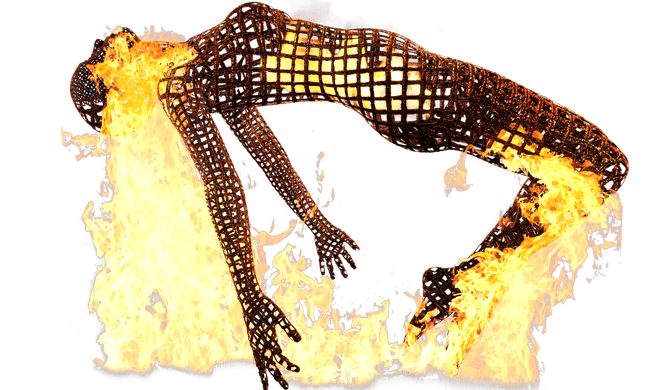Muscle or Fascia
Which is Responsible for Your Pain?

When we look at the THREE TYPES OF PAIN, Type I (simple nociception) is not only the most common, but is also the type that people have the best chance of recovering from (see link). Not to be confused with PROPRIOCEPTION (extremely important in fascia, and defined as the body’s ability to sense where it’s at in three dimensional space), nociception refers to the body’s response to potentially harmful or noxious stimuli (temperature extremes, chemical, mechanical, neurological, etc).
Authors of a brand new study from the latest issue of Pain Reports (Assessment of Pain Quality Reveals Distinct Differences Between Nociceptive Innervation of Low Back Fascia and Muscle in Humans) feel they have made headway in answering the question, “is my low back pain being caused by fascia or by muscle?”
Four researchers from Heidelberg University’s Department of Neurophysiology in Germany took a group of healthy subjects with no history of back pain and tested their pain perception in several anatomical areas (the THORACOLUMBAR FASCIA, the MULTIFIDUS MUSCLE, and deep to or underneath the TL fascia at the L3/L4 lumbar level).
Two different types of electrical stimulation (single and high frequency shocks) were induced, with the subjects grading the pain via a chart that gave them numerous descriptive choices (cutting, beating, burning, tearing, throbbing, scalding, stinging, hot, pounding, and piercing).
Interestingly, the same authors had done something similar using concentrated saline instead of electricity in a 2014 issue of Pain (Sensory Findings After Stimulation of the Thoracolumbar Fascia with Hypertonic Saline Suggest its Contribution to Low Back Pain). Although the concentrated salt water didn’t affect the muscle as far as pain, “Pain descriptors after fascia injection (burning, throbbing, and stinging)… show that the thoracolumbar fascia is the deep tissue of the back that is most sensitive to chemical stimulation, making it a prime candidate to contribute to nonspecific low back pain.“
The same authors came back in the same journal in 2016 (Electrical High-Frequency Stimulation of the Human Thoracolumbar Fascia Evokes Long-Term Potentiation-Like Pain Amplification) showing that yes, there is a difference between pain in fascia and pain in muscles. “Fascia high frequency electrical stimulation increased fascia pain ratings 2.17 times compared with the control site, but had no significant effect on pain sensitivity of the muscle. The high frequency electrical stimulation in muscle had no significant effect on muscle pain, but decreased pain sensitivity of the overlying fascia by 20%.”
This would help explain the analgesic effect of certain types of electrical muscle stimulation on chronic low back pain. The authors went on, “These findings show that the spinal input from the fascia can induce long-term changes in pain sensitivity for at least 60 minutes making it a candidate potentially contributing to nonspecific low back pain.” In their most recent study, the authors determined that….
“Sensory ratings did not differ between single or 100-Hz train stimulation, but there was a tissue-specific rating pattern. Whereas muscle stimulation was more intensely ‘beating’ and ‘throbbing’, fascia stimulation was more intensely ‘stinging’ and ‘cutting’, as well as ‘burning’ and ‘hot’. Electrical stimulation of different soft tissues in the lower back revealed distinct pain quality patterns for muscle vs fascia and skin.
The differences in sensory descriptor patterns between muscle and low back pain may be exploited in physiotherapy and differentially guide treatment towards the respective source of soft tissue; the “deep pain” qualities point towards muscle as the appropriate target, whereas “heat pain” or “sharp pain” qualities point towards fascia.”
Although these authors found differences between muscle pain and fascia pain, current technology is not advanced enough for practitioners to be able to “exploit” these differences to come up with an exact diagnosis with any degree of regularity or certainty. This is why non-specific back pain, while rarely mentioned during doctor visits (the average patient is completely unaware of it’s existence), is routinely discussed in the scientific literature.
What this means for the average chronic low back pain patient is that while terms like “herniated disc” are routinely bantered around by their doctor(s), numerous studies have shown that incidence of ASYMPTOMATIC DISC HERNIATION is over 50% (an indication that the majority of back pain is “non-specific”). And this doesn’t even begin to address the difficulties of using X-rays to determine why a person might be having low back pain (HERE).
MY NEXT POST will discuss what the current science has to say about NON-SPECIFIC LOW BACK OR NECK PAIN, or back pain where a specific tissue cannot be determined as the causative factor for said pain. In the meantime, if you are interested in seeing a mostly DIY protocol for addressing back pain of all sorts, HERE it is.
Because back pain is almost ubiquitous in American society, be sure to like, share, or follow on FACEBOOK if there is someone you love or care about that needs to see this information. And if you are really into fascia, our FASCIA SUPER-POST (over 170 articles on the subject) might be right up your alley as well.
